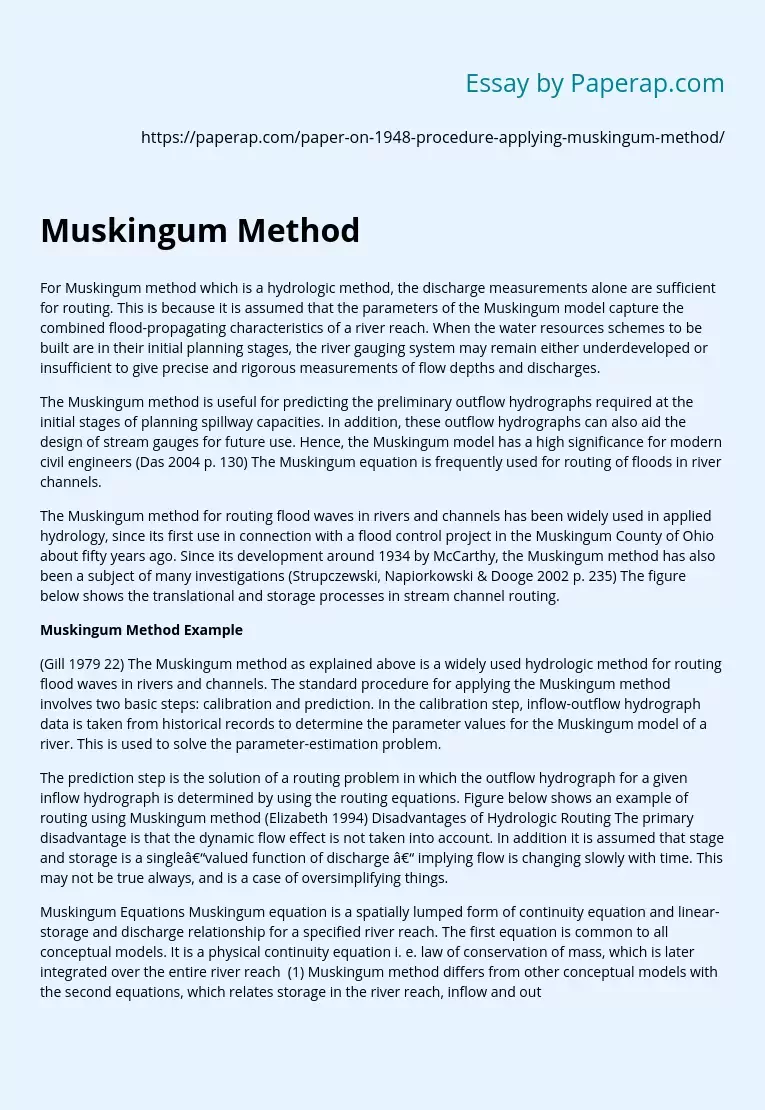For Muskingum method which is a hydrologic method, the discharge measurements alone are sufficient for routing. This is because it is assumed that the parameters of the Muskingum model capture the combined flood-propagating characteristics of a river reach. When the water resources schemes to be built are in their initial planning stages, the river gauging system may remain either underdeveloped or insufficient to give precise and rigorous measurements of flow depths and discharges.
The Muskingum method is useful for predicting the preliminary outflow hydrographs required at the initial stages of planning spillway capacities.
In addition, these outflow hydrographs can also aid the design of stream gauges for future use. Hence, the Muskingum model has a high significance for modern civil engineers (Das 2004 p. 130) The Muskingum equation is frequently used for routing of floods in river channels.
The Muskingum method for routing flood waves in rivers and channels has been widely used in applied hydrology, since its first use in connection with a flood control project in the Muskingum County of Ohio about fifty years ago.
Since its development around 1934 by McCarthy, the Muskingum method has also been a subject of many investigations (Strupczewski, Napiorkowski & Dooge 2002 p. 235) The figure below shows the translational and storage processes in stream channel routing.
Muskingum Method Example
(Gill 1979 22) The Muskingum method as explained above is a widely used hydrologic method for routing flood waves in rivers and channels. The standard procedure for applying the Muskingum method involves two basic steps: calibration and prediction. In the calibration step, inflow-outflow hydrograph data is taken from historical records to determine the parameter values for the Muskingum model of a river.
This is used to solve the parameter-estimation problem.
The prediction step is the solution of a routing problem in which the outflow hydrograph for a given inflow hydrograph is determined by using the routing equations. Figure below shows an example of routing using Muskingum method (Elizabeth 1994) Disadvantages of Hydrologic Routing The primary disadvantage is that the dynamic flow effect is not taken into account. In addition it is assumed that stage and storage is a single–valued function of discharge – implying flow is changing slowly with time. This may not be true always, and is a case of oversimplifying things.
Muskingum Equations Muskingum equation is a spatially lumped form of continuity equation and linear-storage and discharge relationship for a specified river reach. The first equation is common to all conceptual models. It is a physical continuity equation i. e. law of conservation of mass, which is later integrated over the entire river reach (1) Muskingum method differs from other conceptual models with the second equations, which relates storage in the river reach, inflow and outflow.
The equation (2) given above can be obtained by assuming that the total storage in the river reach is a weighted sum of the storages, corresponding to steady-state flow rates in terminating cross-sections, and that a linear relation exists between the prismatic storage and the flow rate. As we have seen in the sections above the two types of storages prism and wedge, and the functions which they depend on. Revisiting the same we get Prism storage = ; Wedge storage = The above equations can be rewritten as Prism storage = ; Wedge storage = The total storage volume at any time instant, t, can be calculating the above two storages.
Muskingum Method. (2019, Dec 05). Retrieved from https://paperap.com/paper-on-1948-procedure-applying-muskingum-method/

